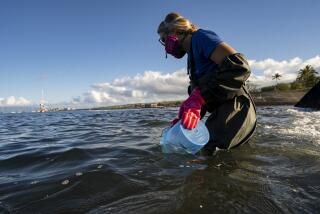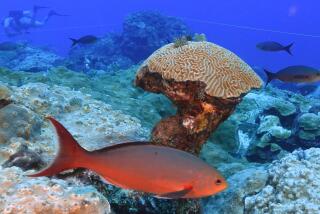Scientists Warn of Damage to Coral Reefs
- Share via
AGANA, Guam — Coral reefs, the marine equivalent of tropical rain forests, are being seriously damaged across Southeast Asia and the Pacific and could become underwater deserts, scientists and development workers say.
Pollution, mining and runaway tourism are among the main causes of the damage, they say, along with sedimentation produced by the erosion of land that results from indiscriminate logging.
“Our main problem is sedimentation which is badly hurting the reef system,” said Charles Birkeland, acting director of the marine laboratory division of the University of Guam.
More than two-thirds of the world’s coral reefs are in Asia.
The Philippines-based Asian Development Bank said in a recent report that coral reefs “are comparable to tropical rain forests in terms of productivity and diversity” and urgently need to be protected.
“Within the last few decades, the increasingly intensive use of land, water bodies and the coast in Asia has created significant disturbance to coral reefs and the coastal environment,” the bank said.
“Many near-shore reef areas have been severely affected.”
The bank said coral reefs provided breeding grounds for thousands of species of marine life, and it would be extremely difficult to revive the reefs if they were destroyed.
Up to 2,000 species of fish live in the more-than-90-mile-long reef surrounding the Pacific island of Palau alone, the bank said.
Birkeland said the worst-hit region was Southeast Asia, especially the Philippines and Indonesia, where demand for food from rapidly growing populations had increased land use and put severe pressure on fragile ecological systems.
The coral reefs scattered among the islands of Indonesia and the Philippines have been damaged almost beyond recovery, and only those in remote areas have remained somewhat intact, Birkeland said.
Reefs around Pacific island states are in relatively good shape, except for those around places like Suva, the capital of Fiji, where the waters are heavily polluted and the reef system is practically dead, he said.
Those in Palau, Yap island and Pohnpei are in “excellent shape,” and even the reef around the U.S. territory of Guam is in good condition compared to the destruction of reefs on Okinawa and the Ryukyus island chain, Birkeland said.
“As you go out in the Pacific, the pollution and sedimentation on the reefs is not so bad. The Australians have done an excellent job protecting the Great Barrier Reef from destruction.”
Dynamite fishing, the mining of reefs for construction materials and uncontrolled tourism have also damaged reefs, the bank report said.
Even though mining reefs is illegal in many countries of Asia, it is widespread in the Maldives, Sri Lanka, southern India and the Philippines.
Birkeland said a thick coat of silt and chemical pollutants on the sea floor may make it impossible for damaged reef systems to grow back.
“The plankton and the animals on the reef don’t come back as well. The little larvae that build the coral get smothered,” he said.
“If there’s a great deal of sediment, the reefs may never come back. A desert is not a bad analogy.”
Australia has managed to protect its Great Barrier Reef, but Birkeland said it was hard to blame people in impoverished nations for exploiting what few resources they had.
Politicians and officials who must provide jobs are not inclined to think about long-term consequences, especially because the income from mining or fishing a coral reef can run into millions of dollars, Birkeland said.
“People don’t think in terms of long-term effects. Nobody wants to plan 10 years ahead. It’s very difficult to tell people not to eat this year and wait until next year,” he said.
The Asian Development Bank suggested that reefs could be preserved as marine parks, but conceded that some countries could not afford to do so.
More to Read
Sign up for Essential California
The most important California stories and recommendations in your inbox every morning.
You may occasionally receive promotional content from the Los Angeles Times.













